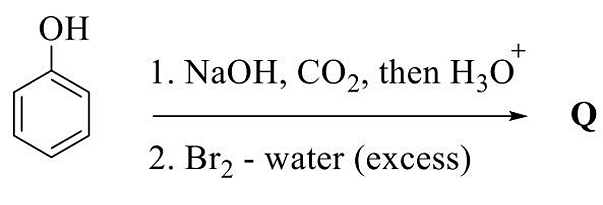A compound gives two fragments in a mass spectrometer. They are C19H7N+ and C19H50+. To separate peaks due to these fragments the instrument should have a resolution of
- They cannot be separated
- 2.417 x 10-2
- 3.402 × 104
- 1.042 × 104
The Correct Option is D
Solution and Explanation
The mass spectrometer peaks given in the question are associated with two fragments, namely, C19H7N+ and C19H5O+. The goal is to determine the resolution required for the instrument to distinguish between these two peaks.
The resolution \(R\) in mass spectrometry is defined as:
\(R = \frac{m}{\Delta m}\)
where:
- \(m\) is the average mass of the two fragments.
- \(\Delta m\) is the difference in mass between the fragments.
First, calculate the mass of each fragment:
- For C19H7N+:
- Carbon (C): 19 atoms × 12.01 u = 228.19 u
- Hydrogen (H): 7 atoms × 1.008 u = 7.056 u
- Nitrogen (N): 1 atom × 14.01 u = 14.01 u
- Total mass = 228.19 + 7.056 + 14.01 = 249.256 u
- For C19H5O+:
- Carbon (C): 19 atoms × 12.01 u = 228.19 u
- Hydrogen (H): 5 atoms × 1.008 u = 5.04 u
- Oxygen (O): 1 atom × 16.00 u = 16.00 u
- Total mass = 228.19 + 5.04 + 16.00 = 249.23 u
The average mass, \(m\), is:
\(m = \frac{249.256 + 249.23}{2} = 249.243 u\)
The difference in mass, \(\Delta m\), is:
\(\Delta m = 249.256 - 249.23 = 0.026 u\)
Now, calculate the required resolution:
\(R = \frac{249.243}{0.026} \approx 9586.2692\)
The closest higher resolution given in the options, which allows for the separation, is \(1.042 \times 10^{4}\).
Therefore, the correct answer is:
1.042 × 104
Top Questions on Mass spectrometry
- The major product in the given reaction sequence is Q. The mass spectrum of Q shows
([M] = molecular ion peak)
- GATE CY - 2024
- Inorganic Chemistry
- Mass spectrometry
- Recombination of electron-hole produces ____ in LEDs.
- AP PGECET - 2024
- Instrumentation Engineering
- Mass spectrometry
- Which among the following characteristics of Laser light specifies the precise movement of all individual light waves together through time and space?
- AP PGECET - 2024
- Instrumentation Engineering
- Mass spectrometry
- Magnetic sector analyzer is a part of
- AP PGECET - 2024
- Instrumentation Engineering
- Mass spectrometry
- Which ionization technique in mass spectrometry is most suitable for large biomolecules like proteins:
- GPAT - 2024
- Pharmaceutical Analysis
- Mass spectrometry
Questions Asked in GPAT exam
- Blood concentration ratio of the combination of trimethoprim and sulfamethoxazole after being given in a 1:5 ratio is
- GPAT - 2025
- antimicrobials
- Which of the following alkaloids are found as salts of meconic acid?
- GPAT - 2025
- Introductory Pharmacognosy
Choose the correct match of laxative and its Mechanism of Action (MOA):

- GPAT - 2025
- Laxative
Match the following:
(P) Schedule H
(Q) Schedule G
(R) Schedule P
(S) Schedule F2
Descriptions:
(I) Life period of drugs
(II) Drugs used under RMP
(III) List of Prescription Drugs
(IV) Standards for surgical dressing
- GPAT - 2025
- Drug therapy
- Which anemia is caused due to Microcytic, hypochromic red blood cells?
- GPAT - 2025
- Organic Chemistry